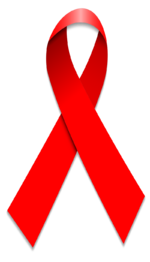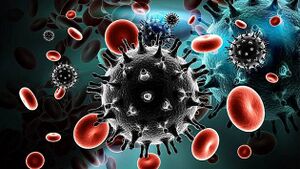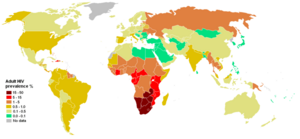AIDS
AIDS stands for Acquired Immune Deficiency Syndrome. It is known since 1981. This disease is caused by a retrovirus called HIV - Human Immunodeficiency Virus. HIV virus causes a loss of immunity, mainly attacks CD4+ T-lymphocytes and macrophages, multiplies in them, kills them, significantly reduce their quantity in the body of an infected person. The decrease in the number of these white blood cells, which are important for the proper functioning of the human immune system, leads to immune failure. The neuro- and lymphotropic properties of the virus allow it to invade the CNS and progressively destroy the immune system (destroying CD4+ T-lymphocytes).
- Transmission
- Horizontal - unprotected sexual intercourse, blood derivatives, parenteral injection of drugs with an infected needle;
- Vertical - mother to child (transplacentally and perinatally).
- Risk groups
- men having sex with men;
- heterosexuals having unprotected sex;
- intravenous substance users;
- haemophiliacs - often infected with infected blood derivatives in earlier times;
- children of infected mothers.
Clinical signs[edit | edit source]
- Acute infection
Acute infection is indicated by fever and swollen nodes. HIV antibodies are formed at the earliest in 1-3 months. Their positivity is the only manifestation in up to 70% of those infected. This stage of symptomatic chronic infection resolves. The onset of the AIDS stage can occur months to decades later.
- AIDS Related Complex
Diarrhea, lethargy, weight loss, opportunistic infections (candidiasis, impetigo). HIV positivity may be accompanied by lymphocytopenia, thrombocytopenia. AIDS is the most severe stage of HIV infection. It means a decrease in CD4+ lymphocytes below 200/mm3 and the simultaneous presence of a severe opportunistic infection or tumour (pneumocystis pneumonia, toxoplasma encephalitis, cryptococcal meningitis tuberculosis, lymphoma or Kaposi's sarcoma). Neurological manifestations occur in up to 80% of patients, and their onset is related to seroconversion and to the late onset of AIDS.
Complications[edit | edit source]
- tumours: kaposi's sarcoma, CNS lymphoma, invasive cervical carcinoma;
- dementia: HIV infection causes demyelination and perivascular inflammatory changes in the brain, followed by intellectual decline;
- retinopathy: caused by CMV, toxoplasma;
- myelopathy: acute reversible on seroconversion, CMV, Herpes zoster + simplex;
- encephalitis: CMV, Herpes zoster or simplex, Toxoplasma, progressive multifocal leukoencephalopathy;
- brain abscess: E. coli, Aspergillus, Candida, Nocardia;
- Meningitis: aseptic on seroconversion, Mycobacterium, Listeria, Aspergillus;
- peripheral neuropathy: acute reversible demyelination on seroconversion, radiculopathy from herpes zoster, chronic demyelination
Treatment[edit | edit source]
![]() If HIV infection is suspected, we start treatment right away!
If HIV infection is suspected, we start treatment right away!
There is still no complete cure for advanced AIDS. Therapy is symptomatic.
- Antiretroviral therapy is currently the mainstay of treatment for HIV-positive people. A combination of several antiretroviral drugs (cART = combined antiretroviral therapy) with different mechanisms of action is used. An example is zidovudine (AZT) - it blocks the production of HIV-specific DNA and thus limits viral replication.
- In suspected cerebral toxoplasmosis - pyrimethamine, sulfadiazine.
- If the CT image does not improve, we indicate a biopsy (lymphoma).
- Treatment regimen according to the causative agent of the opportunistic infection.
- Immunomodulators (IFN, IL-2).
Untreated AIDS inevitably ends in fatal infection or malignancy. Treatment today is so effective that the life expectancy of HIV-positive people is approaching that of the healthy population.
Links[edit | edit source]
Related articles[edit | edit source]
Sources[edit | edit source]
- Rozsypal, Hanuš. . Základy infekčního lékařství. - vydání. Charles University in Prague, Karolinum Press, 2015. 572 s. ISBN 8024629321.
- ↑ Skočit nahoru k:a b c d SEIDL, Zdeněk a Jiří OBENBERGER. Neurologie pro studium i praxi. 1. vydání. Praha : Grada Publishing, 2004. ISBN 80-247-0623-7.
- ↑ Národní program boje proti AIDS. Detailně o AIDS [online]. ©2010. [cit. 2010-06-02]. <http://www.aids-hiv.cz/index.html>.




